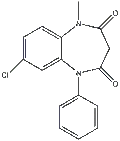Clobazam
Clobazam is a drug which is a benzodiazepine derivative. It has been marketed as an anxiolytic since 1975 and an anticonvulsant since 1984. more...
Pharmacology
Clobazam is a 1,5-benzodiazepine, meaning that its diazepine ring has nitrogen atoms at the 1 and 5 positions (instead of the usual 1 and 4). Like other 1,5-benzodiazepines (arfendazam, lofendazam, e.g.), it has less affinity for the ω1-allosteric binding site on the GABAA receptor compared to the 1,4-benzodiazepines. It has selective affinity for the ω2 site, where it has agonistic activity.
In a double-blind placebo-controlled trial published in 1990 comparing it to clonazepam, 10mg or 20 mg of clobazam was shown to be much less sedating than either 0.5mg or 1 mg of clonazepam.
The ω1-receptor, which is found on the α1 subtype of the GABAA receptor, was shown to be responsible for the sedative effects of diazepam by McKernan et al in 2000, who also showed that its anxiolytic and anticonvulsant properties could still be seen in mice whose α1 receptors were insensitive to diazepam. It would seem, then, that the anticonvulsant properties of clobazam are due to its selective affinity for ω2.
In 1996, Nakamura et al reported that clobazam and its active metabolite, N-desmethylclobazam (norclobazam), work by enhancing GABA-activated chloride currents at GABAA-receptor-coupled Cl- channels. It was also reported that these effects were inhibited by the GABA antagonist flumazenil, and that clobazam acts most efficiently in GABA-deficient brain tissue.
Nine years earlier, Kilpatrick et al noted that there was a correlation between plasma levels of norclobazam and therapeutic effects, although this was not true with the parent compound.
According to Valli and colleagues in 1984, clobazam lowered prolactin levels elevated by sulpiride, a typical antipsychotic. Hyperprolactinemia (i.e. elevated blood prolactin) occurs occasionally in people using antipsychotics, (particularly the typical ones), and can lead to cardiovascular disease, breast cancer, galactorrhea, infertility, amenorrhea, dysmenorrhea, osteopenia, osteoporosis, loss of libido, impotence, and hypogonadism.
Read more at Wikipedia.org



